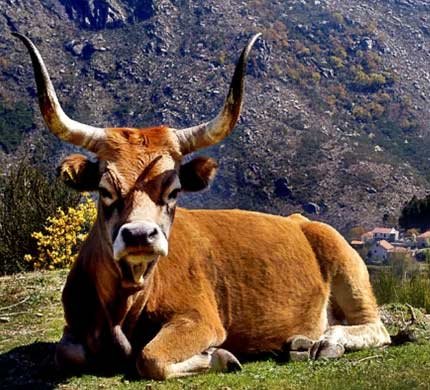Cachena
- Temperature:10°C to 20°C
- Milk:1 to 2 gallons per day
- Food:Grasses, Herbs and Shrubs
- Pregnancy:Approximately 9 months
- Nationality:Spain

General Information
Cachena is a small, hardy breed of cattle that is native to the mountainous regions of northwestern Spain, particularly the Galician province of Lugo. They are a dual-purpose breed, meaning they are used for both meat and milk production. Cachena cows are relatively small, with a height of about 1 to 1.2 meters at the shoulder and a weight ranging from 250 to 400 kg. They have a distinctive coat coloration of reddish-brown, with white or black markings on their face, legs, and belly.
Cachena cattle are known for their adaptability to harsh mountain environments, with their hardiness and foraging ability allowing them to thrive in areas where other breeds might struggle. The breed has faced declining numbers over the years, but conservation efforts are underway to preserve the genetic diversity and cultural heritage of Cachena cattle.
Where we find this cow to buy?
Here are some resources that may help you find Cachena cattle for sale:
Cachena cattle are primarily found in their native region of northwestern Spain, particularly in the province of Lugo.
If you are interested in purchasing Cachena cattle, you may want to reach out to local breeders or farmers in this area.
In addition, there may be breed associations or conservation groups that can provide information on breeders or sales.
It’s important to note that Cachena cattle are a relatively rare breed, so finding them for sale may be more challenging than with more common breeds.

How to increase milk production in Cachena
Cachena cattle are a beef breed and not typically raised for milk production. However, if you are looking to increase the milk production of any breed of cattle, there are several strategies that can be effective:
01
Feeding cattle a well-balanced diet that meets their nutritional needs can help improve milk production. This may include providing high-quality hay or pasture, along with supplements like grain or protein concentrates.
02
Milking techniques and hygiene can help prevent infections and improve production.
03
Providing clean, dry, and comfortable housing or pasture for the cows can help reduce stress and improve milk production. It’s important to ensure that cows have adequate space, good ventilation, and access to clean water.
04
Selecting cows with a history of good milk production can improve overall milk production.
Medicine
Cachena is a breed of cattle that is native to the Galician region of Spain. Like all cattle, Cachena may require veterinary care and treatment at times to maintain their health and wellbeing. Here are some of the common types of medicines that may be used for Cachena:
01
AntibioticsAntibiotics are used to treat bacterial infections in Cachena cattle.
02
AnthelminticsAnthelmintics are used to treat parasitic worm infestations in Cachena cattle.
03
VaccinesVaccines are used to prevent infectious diseases in Cachena cattle.
04
Anti-inflammatory drugsAnti-inflammatory drugs are used to reduce inflammation in Cachena cattle.
Pregnancy
The first step in the pregnancy process is breeding. This usually involves introducing a bull to a group of cows to mate and fertilize their eggs.
Monitor the cow closely during calving to ensure a safe delivery. Signs of labor include restlessness, frequent urination, and contractions.
Postnatal care is essential for cow and calf, including monitoring health and providing a safe environment.
At around 6-8 months of age, the calf can be weaned from the cow and begin a diet of solid food.
Important!
After giving birth, the cow will typically enter a reproductive cycle and become capable of breeding again. It’s important to monitor the cow’s reproductive cycle to ensure proper breeding intervals and optimal fertility.
Food
The diet of Cachena cattle primarily consists of grass, hay, and other fibrous forage, which makes them well-suited for grazing in harsh environments. The specific types of food that are fed to Cachena cattle can vary depending on factors such as geographic location and seasonal availability. In addition to forage, some common types of feed that may be given to Cachena cattle include:
This type of feed is a high-energy supplement that is often fed to cattle to increase their weight gain and milk production. It typically includes ingredients such as grains, oilseeds, and protein sources.
Silage is a fermented feed made from crops such as corn or grass that are chopped and stored in an anaerobic environment. It is often used as a winter feed for cattle.
Cachena cattle need minerals and nutrients to maintain their health and well-being, so mineral supplements can be added to their diet.
Clean and fresh water is essential for the health and productivity of all cattle, including Cachena cattle. They should have access to clean water at all times.
Facts
Here are some interesting facts about Cachena cattle:
The breed was almost extinct in the mid-twentieth century, but its numbers have increased due to conservation efforts.
They are a small breed of cattle, with cows weighing around 400-500 kg and bulls weighing around 600-700 kg.
The coat color of Cachena cattle is usually a reddish-brown or chestnut color, although some individuals may be black or white.
Cachena cattle are adapted to the harsh climatic conditions of their native region and thrive in areas with limited food resources.
This breed is considered a “genetic reserve” by the FAO due to its unique genetic traits and cultural significance.
Due to their small size and hardiness, Cachena cattle are popular with small-scale farmers and homesteaders.
Cachena cattle are a rare breed of cattle native to the northwestern region of Spain.
Cachena cattle are known for their calm and docile temperament, making them easy to handle and work with.